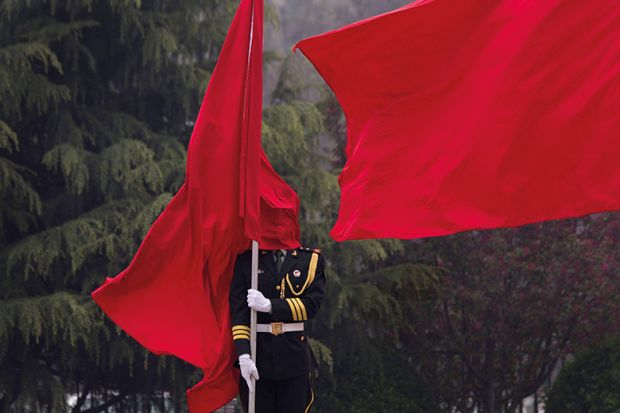The Great Firewall of China has recently been upgraded. Ahead of the five-yearly National Congress of the Chinese Communist Party in October, a new crackdown blocked a series of encryption tools that allowed internet users to bypass censorship controls, with Google results now off-limits to even the most digitally savvy Chinese citizens.
There is, however, a more insidious way of censoring ideas that the Chinese government does not want to be circulating freely: remove them at source from the scholarly literature. That is what has been happening in recent years, with books and articles disappearing from certain academic publishers’ online platforms in China if they feature blacklisted keywords, such as Tiananmen, Tibet, Taiwan, Xinjiang, Falun Gong, Hong Kong.
The issue came to light five years ago, when it emerged in the UK's national press that Cambridge University Press (CUP) had removed “sensitive” content from its prestigious China studies journal, China Quarterly. Since then, other publishers have faced similar accusations of bowing to pressure from Beijing. Springer Nature has restricted access to more than 1,000 articles, while Taylor & Francis, Sage Publishing and Brill have navigated strict content restrictions.
Although some publishers have found routes to navigate these restrictions without self-censoring their online platforms, others appear to be more deeply enmeshed in China’s censorship apparatus – and in recent years, the access constraints facing so-called controversial papers have gone much further than many believe, straying beyond familiar red-flag topics on an unprecedented scale.
By comparing UK-based and China-based IP addresses and the content discrepancies between the two, I’ve managed to gain some handle on the scale of publication data that is now inaccessible in China. My analysis suggests that more than 28,000 records of publication have been suppressed on publisher platforms accessible by Chinese scholars or the public.
Unsurprisingly, the absences include recent articles critiquing Xi Jinping’s leadership and ideology, his anti-corruption purge and nascent social protest movements. Papers about Chinese intellectual discourse on democracy have also gone. Confirming earlier fears of Covid censorship, newly published books and chapters on China’s handling of the pandemic return a “page not found” message. And the discrepancies extend to topics beyond China’s borders: content platforms accessible in China are also missing articles and book-length studies on the collapse of state socialism in eastern Europe, ethnicity and class identity in Korean cinema, and the religious freedom of Muslim women in India.
The body of unavailable content includes research outputs funded by public bodies with clear open access mandates. Early analysis of a sample of publication records suggests that these access restrictions are due to some form of automated screening. However, a subset of these absences, if they do relate to censorship concerns, appear to have been targeted in ways that suggest a more nuanced application of the Chinese government’s import regulations.
One example is an article in a criminology journal, which, as far as the online record of publication is concerned, is available everywhere except China. It concerns the presumption of innocence as a cornerstone of liberal jurisprudence. Significantly, this article does not contain any keywords that are overtly “sensitive”, either in the title, abstract or text. One possibility is that a more sophisticated form of natural language processing has been employed to screen content. Another is that someone – a human, not a machine – has decided that a scholarly argument in favour of the universal human right to be presumed innocent – contra the arbitrary detention of political activists – would not be admissible in the Chinese market.
This more attentive attitude towards “sensitive” material reflects tighter vetting criteria, which are now more obvious for publishers – and more problematic. In October 2019, China’s General Administration of Press and Publications released a seemingly mundane notice on “measures for the recording of major subject selections of books, periodicals, audiovisual products and electronic publications”. Buried in it are a series of explicit – and expansive – constraints on the publication and distribution of sensitive material, known as “major selected topics”. Their scope includes all mention of the Chinese Communist Party; “speeches, writing [and] articles” on the “work and life of current and former party and state leaders”, Hong Kong, Macao and Taiwan’s “special administrative status”; “ethnic and religious issues”; and, limitless in its latitude, “important social affairs”. These topics extend beyond China’s disputed borders, including “events involving the Soviet Union [and] eastern Europe” and “the selection of major leaders” in communist countries, past and present.
Publishers and distributors of published material are obliged to register all relevant works for written approval, with the promise of annual inspections and “administrative sanctions” for individuals that fail to comply.
Although this regulation concerns domestic entities in China, as we saw with CUP and other Western publishers, non-Chinese entities are also bound by the same constraints because publishers cannot trade directly with academic institutions and libraries in China: sales deals are brokered, instead, via Chinese publication importers. However, given the scale of material involved, screening and preapproving “non-sensitive” content is a Herculean administrative task that neither party is well equipped (technologically or linguistically) to manage in isolation. As a result, English-language publishers have faced pressure to work with Chinese research importers to help enforce the rules.
China’s regulations concerning the import of overseas publications are not the only source of pressure on publishers to self-censor their records of publication. In 2020, the country’s research assessment framework shifted from one that incentivised quantity over quality to a new “representative works” model: assessment is now limited to a defined quantity of outputs, a third of which must be published in domestic journals and none of which may appear in an “early warning” list of journals deemed to be low quality or predatory. But it is not just quality that is under scrutiny: the detailed set of criteria for admissible international publications in the humanities and social sciences, released by China’s Ministry of Education, raises fresh censorship concerns.
Researchers must, for example, “adhere to the correct political direction” and must not “deliberately dwarf and vilify China in pursuit of international publication” or “damage national sovereignty, security and development interests”. Given growing support in China for paid open access outputs in international journals, this policy development creates a strong incentive for publishers to tailor their publications along political lines.

With constraints on the scholarly record in China tightening daily, obscuring the knowledge base on topics of global concern, I was eager to canvass opinion on this expanding threat to academic freedom. Are academics aware that their work has been rendered inaccessible by Western scholarly publishers operating in China? Are implicated publishers concerned about the reputational risks run by this fraught compromise in the Chinese market?
As part of my doctoral research, I spoke to publishers and Asia studies academics who have faced censorship in China. Some of the 12 publishing executives I interviewed held leadership positions between 2017 and 2019 – the period when the controversies arose. For a rounded perspective, I also spoke to others who worked for companies unconnected to reported cases of censorship complicity. To understand the impact of these cases, I interviewed 12 academics whose work had been removed from circulation in China at the request of Chinese research importers.
Most interviewees seemed unsurprised by allegations of self-censorship levied at academic publishers in recent years. But some, especially publishers, were bewildered that the issue had not gained more traction and that CUP was one of the few to receive sustained press coverage. “That our own involvement didn’t become a bigger news item is the only surprising thing,” confided one senior employee of a commercial press.
The suppression of journal papers clearly troubled publishers and academics alike. Most disagreed with the so-called 1 per cent argument found in some publishers’ public statements: that suppressing a small proportion of “sensitive” articles is permissible in order to preserve access to the greater majority. Many found it hard to accept this stated motive for compliance, instead regarding such rationalisations as a means to remain in the lucrative Chinese market.
Most blamed industry leaders, trade bodies or governmental agencies for allowing self-censorship to become so widespread. Some even pointed the finger at the wider Asia studies community – particularly in the UK – for having failed to coordinate a more active resistance. To my surprise, however, several Asia studies academics, including journal authors and editors, urged the case for pragmatism; three of them were in favour of the “1 per cent” argument. “Perfect can sometimes be the enemy of good, so I would go for good, rather than perfect,” explained one scholar.
Censorship matters for global research. By preventing access to records of published research outputs, duplication of research can occur, while academics may even face accusations of fraud if they cite material that appears to be non-existent when applying for new posts or promotions. But some interviewees wondered if the outrage about reported cases of censorship complicity was really justified. For the most part, censored authors were not “heroic” China-based dissidents, interviewees pointed out, but established scholars at US or European universities, for whom the consequences of being censored in China are limited.
As for the former group, some journal editors described the ethical bind they would face if they took a more principled stance: in practice, they would be promoting law-breaking in order to allow China-based journal authors to participate in global scholarship. And despite the recent crackdown, many interviewees explained that the use of virtual private networks (VPNs) in China remains widespread, allowing Chinese scholars ongoing access to “unauthorised” material – albeit at an increased personal risk.
The complexity of the challenges facing the scholarly publishing industry cannot be overstated. Publishers must attempt a perilous balancing act between their sincere investment – not purely financial – in global knowledge exchange and the regulatory constraints of the Chinese market. The ability of some publishers to operate in China without redacting their platforms appears to undermine the legitimacy of the 1 per cent argument – although it remains to be seen whether this “publish and be damned” attitude can survive the latest crackdown.
If publishers are unable to extricate themselves, for financial reasons, from China’s censorship machine, maybe there is space for industry bodies – or perhaps academics or even politicians – to play a role in establishing and enforcing some minimum standards when it comes to the online scholarly record in China. This could take the form of guidelines on platform amendments (as for retractions, corrigenda and errata), whereby amendments are, at least, documented and disclosed. The Committee on Publication Ethics is the closest the academic publishing industry has to a regulatory body, and its priorities reflect those of the industry and of academia at large. It would be well placed to take on this role.
Unless the publishing industry faces scrutiny – from within or without – it will have little impetus to change. Until then, an ethically fraught route to compliance remains available to publishers that choose to take it. That is to suppress content that the Chinese government might not like without even any public acknowledgement, let alone debate on whether such compromises are justified in pursuit of maximising knowledge dissemination.
George Cooper is a publishing professional and a PhD candidate at UCL’s Centre for Publishing in the Department of Information Studies. This article gives the views of the author and not the position of UCL or his employer.
Register to continue
Why register?
- Registration is free and only takes a moment
- Once registered, you can read 3 articles a month
- Sign up for our newsletter
Subscribe
Or subscribe for unlimited access to:
- Unlimited access to news, views, insights & reviews
- Digital editions
- Digital access to THE’s university and college rankings analysis
Already registered or a current subscriber? Login








